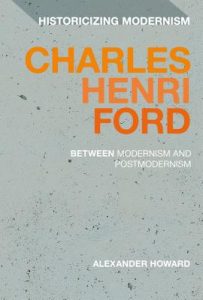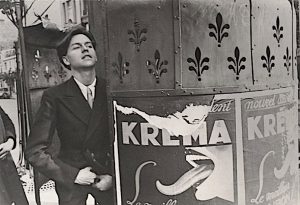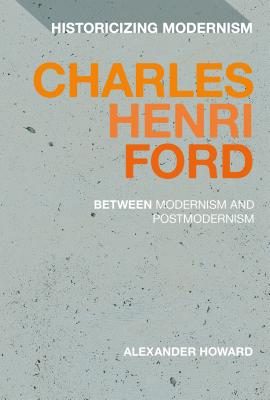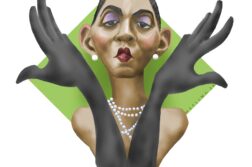 Charles Henri Ford: Between Modernism and Post Modernism
Charles Henri Ford: Between Modernism and Post Modernism
by Alexander Howard
Bloomsbury. 251 pages, $114.
IT’S QUITE POSSIBLE that only a few readers of this magazine will know who Charles Henri Ford was. Yet here we have a lengthy and heavily annotated book from Bloomsbury Press about his work—or, rather, about certain aspects of his work. After all, Ford was nothing if not a consummate dilettante in the old sense of the word: he wrote poetry; he edited magazines; he co-wrote a novel banned for decades in the U.S.; he made films; he drew and painted; and in the end he left a diary titled Water from a Bucket (2001), admirably edited by Lynne Tillman, which surpassed all previous literary works for name dropping.
Ford could name-drop so well because he was born in 1908 and died in 2001; he lived in New York, and Paris, and then all over, and then in New York again. He was beautiful when young, and still handsome in his nineties. There’s a famous photograph by Henri Cartier-Bresson of Ford at thirty buttoning his fly outside a Montmartre pissoir. He had love affairs with famous people like Djuna Barnes and the painter Pavel Tchelichev, who were at the culture centers of their time. He befriended André Breton and the Surrealists, and during World War II he brought them to America. He was curious, intellectual, and talented, with a celebrated stage actress sister, Ruth Ford; and he lived as well as anyone of his era (for a time in the Dakota in New York City). All the nastiness of mid-20th-century history seemed to bounce off Ford like bad reviews of a hit show.
One wouldn’t know many of these facts from Alexander Howard’s tome, Charles Henri Ford: Between Modernism and Postmodernism, however, because Howard is after different game: he wishes to show how Ford spanned the two literary movements of the past century. Which is all well and good, and I agree with his analysis, but not with how he arrived at it. Howard appears to be a poetry critic primarily, which may be why he completely misses the outstanding fact of Ford’s life for us now, a decade and a half after his death. What stands out is not Ford’s poetry but that he co-wrote the 1933 novel, The Young and Evil, with his friend (and probable sex partner) Parker Tyler, a prescient film critic who wrote Screening the Sexes and Underground Film, among other books. The novel, published by Obelisk Press in Paris and smuggled out of France, was, in Gore Vidal’s words, “doubtless the first and still most crucial queer novel written.“ Vidal’s recommendation led to the first U.S. publication of the book, by the Gay Presses of New York (through its SeaHorse Press line), in 1986.

The U.S. edition contained a lengthy and factually rich prologue by scholar Steve Watson, and it sported cover art and a foldout of ten pen-and-ink drawings that Tchelichev had done for Ford’s own private edition of the book: artwork never previously seen, rescued from the depths of a steamer trunk, which slowly wended its way from Katmandu, Nepal, where Ford kept a home.
The Young and Evil isn’t a great novel, although it is fun to read. It’s too campy for any kind of “plot” to hold onto, and its characters are mostly known through their 1930’s campy dialogue. If anything, it’s closer to a postmodern work than to a conventional novel—a half century before that movement emerged. Ford’s own, quite accurate words about it to me were that it was “quite deliciously madcap.” He thought it was surrealistic, and maybe it is, but it’s more like what a 25-year-old woman author from the depths of super-hip Brooklyn with too many gay pals might write next week. Ford would have loved reality TV and would have perfectly fit in with the Real Housewives of Beverly Hills. He believed that anything could become “art,” especially all the trivia of our lives, and he worked on this assumption.
Howard gives the novel about four sentences in his book. And, given that he cites the Gay Men’s Press edition of the book in a footnote, a 1989 reprint and not the 1986 U.S. edition, it’s pretty clear that Howard never saw either edition and possibly never read the novel. So, what does he include in this book? He writes about Andy Warhol and Ezra Pound. He writes about Pound’s influence upon Ford as a poet, which seems a stretch, and he includes almost half a chapter about Pound’s later cantos, Drafts and Fragments. As for the Warhol influence, it was actually poet Gerard Malanga, a Factory hanger-on, with whom Ford palled around for years.
If you want to know more about Charles Henri Ford, find that Steve Watson essay and read the novel. Or read various interviews with Ford in the mid-80’s. Or read the sixth chapter of my book, True Stories: People and Places from My Past, titled “The Absolutely, Very Last Surrealist, Charles Henri Ford.” Any of those will give more of a picture of Ford and his unique personality and, sadly, his somewhat marginalized literary existence—sadly, because he so wanted to be at center of it all.
Felice Picano’s latest book is a memoir titled Nights at Rizzoli (OR Books).






